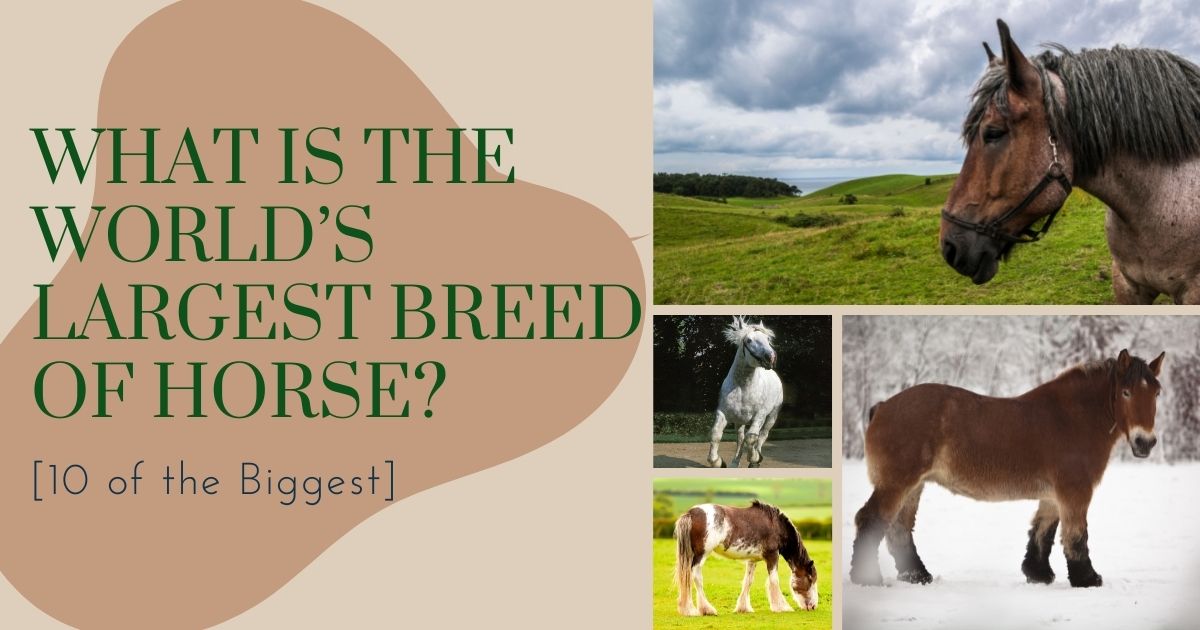Large Horse Breeds
While all horses are beautiful and special in their own way, there is something incredibly captivating about huge horses. Today, we sample the largest breed of horses, and their height, weight, life expectancy, etc.
Horses have been domesticated for many years, resulting in variations between the different breeds. Most big horses are draft horse breeds. Farmers specifically bred these horses to pull heavy supplies and equipment.
Other than drafting, big horses are also commonly used in horse racing. If you have ever attended a horse race, you must have seen horses that get you wondering what the tallest breed of horse is, or what is the largest breed of horse in the world?
Large horse breeds are not riding horses. It is impossible to ride them due to their big size. People still use big horses to pull things today. Most big horses have a lot in common. However, certain qualities set them apart from one another.
What’s the World’s Largest Breed of Horse?
There are many breeds of horses in the world today. While others are big, some are small and medium-sized. For many years, human beings have bred horses to assist them with all types of jobs. Over time, horses have been useful in pulling chariots, racing, and riding in parades.
Horses are amongst the first domesticated animals. The main reason for breeding big horses was to assist on the farm by pulling carts and plows. Besides assisting on the farm, the tall and strong horses were also useful in times of war.
To date, humans still use draft horse breeds to pull heavy loads. So, what is the largest breed of horse in the world? Read on to find out!
American Cream Draft
Quick Facts
Country of origin: United States of America
Height: 15.1 to 16.3 hands (1.51 to 1.63 meters)
Weight: 1,600 to 1,800 pounds (720 to 810 kilograms)
Life expectancy: 25 to 30 years
Feeding: Hay, grass, grains
Time of development: 1900
The American cream draft is the newest of the huge horse breeds and is the only ancient draft horse breed that originated in the U.S.A. It has a beautiful cream coat, lovely amber eyes, and a white mane and tail.
Their coat color is the most notable feature of this horse breed. It ranges from pale green to gold, with a white mane and tail. Some have hazel-colored eyes and white markings on their coats.
Initially, farmers domesticated this horse to assist them in pulling heavy loads and agricultural work. Today, the American cream draft is commonly useful in films, shows, and horse sports.
The draft horse breeds are amongst the biggest horse breeds to ever exist. These horses are obedient and willing to work, making them one of the best work horse breeds. They have classic draft horse features, including a wide chest, well-muscled hindquarters, and a short, strong back.
Australian Draught
Quick Facts
Country of Origin: Australia
Height: 16 to 17.2 hands (1.6 to 1.72 meters)
Weight: 1,320 to 1,980 pounds (594 to 891 kilograms)
Life Expectancy: 20 to 30 years
Feeding: Hay, grass, grains
Time of Development: 1850
Scottish settlers discovered the Australian Draught in the 1850s. In the 1800s, farmers used bullocks in heavy draught works. There was a need for strong draught horses for quicker movement. It was during this time that the Australians developed this breed.
The Australian Draught is a product of four pure work horse breeds: Percheron, Shire, Clydesdale, and Suffolk Punch.
Famous for its hardiness, strength, and moderate temperament, Australian Draught was originally useful for draught work. These horses pulled heavy rail wagons on the sidelines and docs. However, people use this horse for riding, shows, and farm work in modern days.
Due to the different horse breeds used in coming up with this horse, the Australian Draught
coats can be black, gray, white, brown, or roan. Breeders recently added the Belgium draft to the horses used to produce this breed. This move has resulted in more traits and colors within this breed.
Some of the evident physical traits include well-muscled shoulders, clear alert eyes, a wide chest, hips, and hindquarters, a strong physique, and medium-feathered legs. Despite being a huge horse breed, the Australian Draught is kind-hearted, polite, and trainable.
Belgian Draft
Quick Facts
Country of Origin: Belgium
Weight: 1,800 to 2,200 pounds (810 to 990 kilograms)
Height: 15 to 18 hands (1.5 to 1.8 meters)
Life Expectancy: 18 to 24 years
Feeding: Hay, grass, vegetables, grains
Time of Development: 1850
Belgium is the country of origin of the Belgian draft. Developed in the 1850s, this horse breed is famous for its strength and stamina.
Originally called the Flanders Horse, the Belgian Draft horse is one of the horses classically used for farming. In modern-day, the horse is still useful in cart pulling, agricultural work, and riding circles.
Like the Shires and Clydesdales horse breeds, Belgian Drafts have feathered hooves. However, unlike these two breeds with long beautiful necks, the Belgian drafts have short, muscular necks. Most of these horses are bay, sorrel, chestnut, or ronin color.
Although Belgian Drafts are shorter than most big horse breeds, some grow as huge as the Shire! Brooklyn Supreme is the most common giant Belgian Draft horse, having grown 19 hands tall and weighing over 3,000 pounds (1350 kilograms). The Belgian Drafts are industrious, brave, tough, gentle, and sensible.
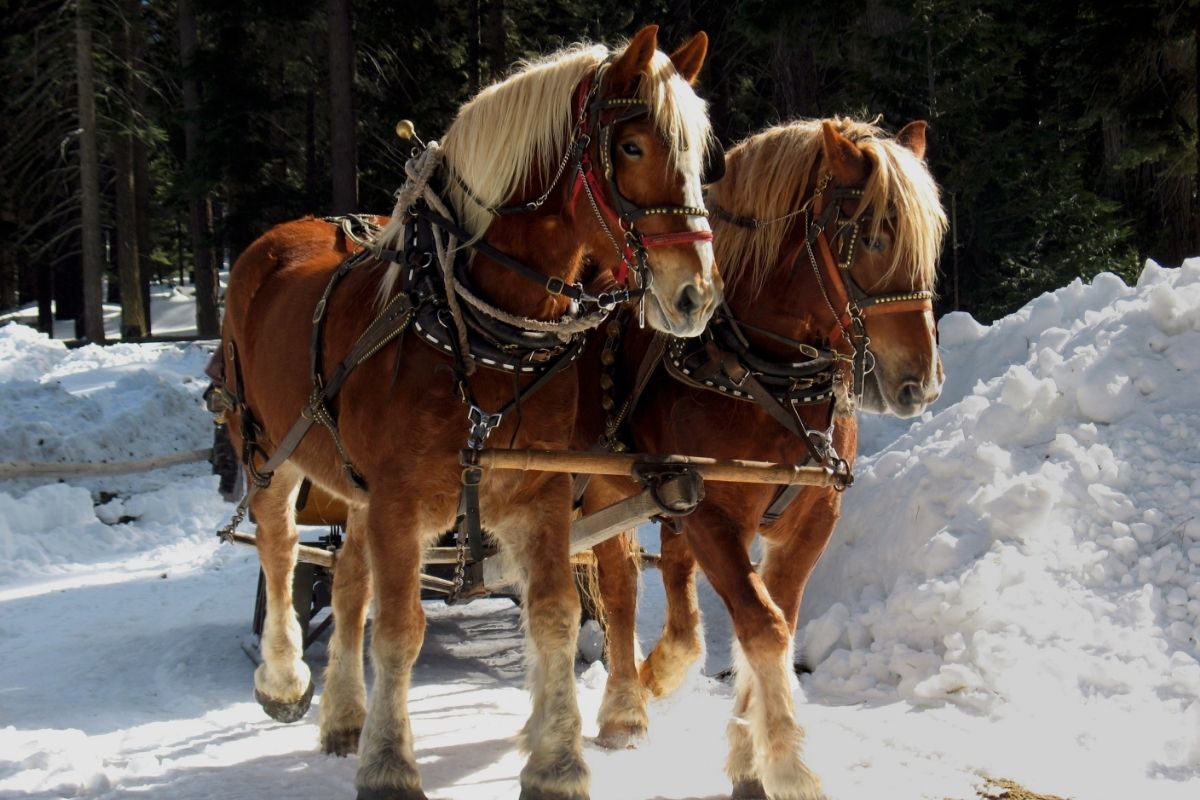
Boulonnais
Quick Facts
Country of Origin: France
Weight: 1,250 to 1,650 pounds (563.4 to 742 kilograms)
Height: 15.1 to 17 hands (1.53 to 1.7 meters)
Life Expectancy: 20 to 25 years
Feeding: Hay, grass, vegetables, grains
Time of Development: 1800
Also referred to as the White Marble, Boulonnais is the smartest of all large horse breeds. These horses are referred to as the “white marble” and “polished marble” because of their delicate skin and visible veins. The Boulonnais horse breed has been around for a very long time. Its history dates back to when there were no crusades.
Historians argue that you can track this breed back to the horses that the cavalry of Julius Caesar left behind before taking over England.
Breeders have crossed Boulonnais horses with several breeds like the Arabian and Spanish Barb to refine them through the years. They further intercrossed the offspring to create other huge horses.
Although Boulonnais horses are typically colored white, modern breeds sometimes have a chestnut or black coat. The dominance of their white color is another reason people call them white marble horses.
They have a wide forehead, a short, distinctive head, and small, erect ears. Boulonnais horse breeds have a thick muscular neck and strong, solid legs with clean joints.
Boulonnais horses are strong and can be useful in many areas. For centuries, these horses have been used to pull wagons, assisting in fieldwork and transportation. Because of their strong nature, they were also helpful during war times. Besides helping in work matters, Boulonnais are also bred and raised for meat.
Despite being among the strongest horse breeds, these horses are energetic, social, and active. These qualities make them great companions!
Clydesdale
Quick Facts
Country of Origin: Scotland
Height: 16 to 18 hands (1.6 to 1.8 meters)
Weight: 1,800 to 2,000 pounds (810 to 900 kilograms)
Life Expectancy: 20 to 25 years
Feeding: Hay, grain, fruits, and vegetables.
Time of Development: 1826
Breeders first discovered the Clydesdale horse in Scotland, in the Clyde valley. Clydesdales are energetic, highly trainable, and naturally easy-going. Their common characteristics include a broad forehead, feathery legs, and a long arched neck. Clydesdale is slightly smaller than the Shire horse breed.
This horse breed is famous for its high stepping gait. Clydesdales have bay-colored coats with white markings on the legs, feet, and face. Some of these horse breeds also have markings under the belly. A Clydesdale can also be gray, black, or chestnut.
Because of their energetic nature, Clydesdale was originally useful in carrying out manual labor in farms and industries. During the First World War, these horses were used to transport soldiers and guns to the battlefield.
Today, the Clydesdale horses are primarily useful in carriage, drum horses, and leisure riding. These horses are beautiful! Their white-feathered hooves give them a flashy appearance. Clydesdales are commonly useful in shows, parades, and other ceremonial events.
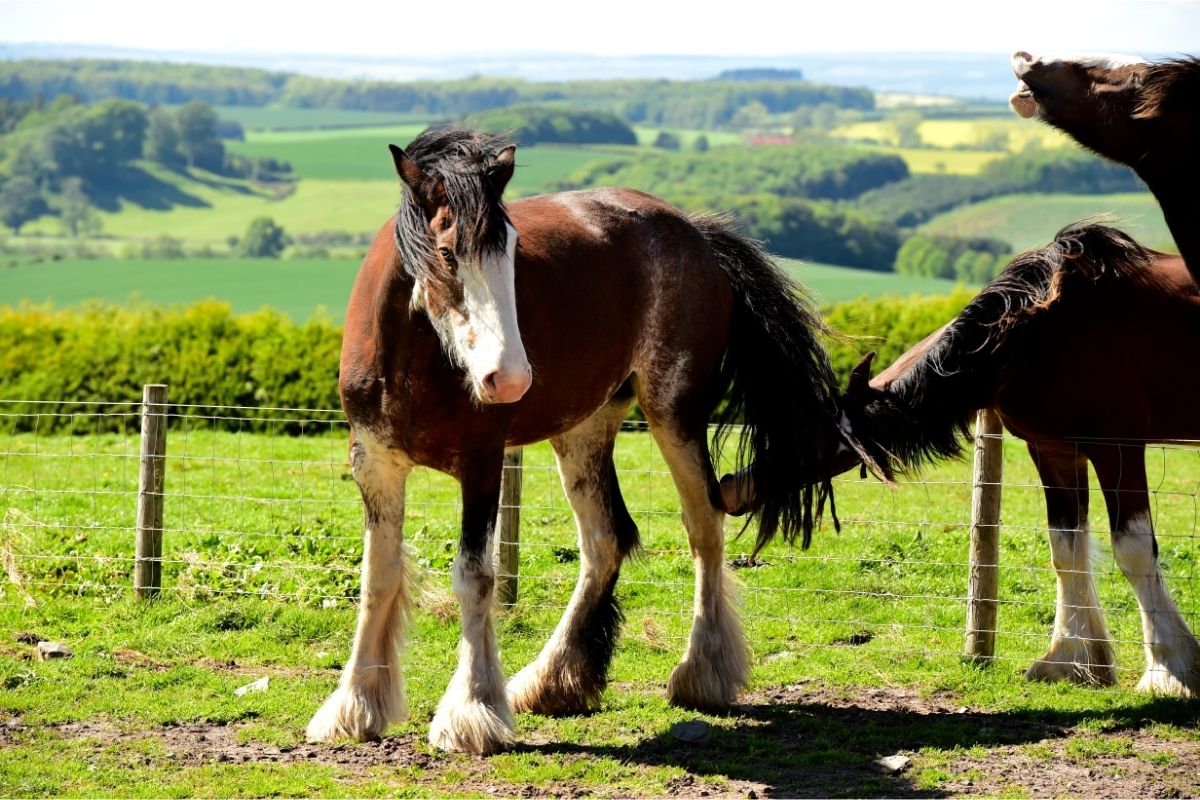
Dutch Draft
Quick Facts
Origin: The Netherlands
Weight: 500 to 1,700 pounds (225 to 765 kilograms)
Height: 15 to 17 hands (1.5 to 1.7 meters)
Life Expectancy: 15 to 20 years
Feeding: Hay and grain
Time of Development: 1914
Dutch Draft is one of the golden breeds of horses ever to exist, and it is the strongest horse breed ever known. The Dutch Draft is a crossbreed of the Ardennes and the Belgian Draft. It is also the most popular for ancient horse activities such as horse races and acrobatics.
Historically, Dutch Drafts were useful in farming activities, where they mainly pulled heavy loads. Today, these horses are used in horse sports, pulling carts, and cartridges. They are also useful in parades, driving and pleasure riding,
Since their key role was assisting with farmwork, Dutch Draft horses were largely affected by mechanization. Thankfully, this breed is not extinct, and its numbers are stable.
These horses are clever and have very calm behavior. Dutch Drafts are also known to walk slower than most big horse breeds. Although they are giant-sized, these horses are exceptionally gentle and quiet.
Dutch Draft horses have a gray, bay, or Chestnut coat. These horses also have short legs, a straight head, and an overall muscular body. They have beautiful feathered hooves inherited from their Belgium ancestors.
Jutland
Quick Facts
Country of Origin: Denmark
Height: 15 to 16.1 hands (1.5 to 1.61 meters)
Weight: 1,430 to 1,760 pounds (643.5 to 792 kilograms)
Life Expectancy: 25 to 30 years
Feeding: Hay and grain
Time of Development: 1850
This horse breed got its name from the well-known Jutland Peninsula. Jutland is amongst the most popular horses used in films, shows, and festivals. It is also one of the easiest horses to domesticate because of its calm nature.
Although most Jutland horses are chestnut-colored, others come in black, gray, bay, or roan colors. Some also have white markings on their face and legs. The physical features inhabited by Jutland horses include a short and arched neck, straight shoulders, and a short, muscular back.
Like many other large horse breeds, Jutland horses were mainly used as workhorses. Today these horses are mainly used for general riding, endurance riding, and other horse sports.
Percheron
Quick Facts
Country of Origin: France
Height: 15 to 19 hands (1.5 to 1.9 meters)
Weight: 1,900 to 2,000 pounds (855 to 900 kilograms)
Life Expectancy: 25 to 30 years
Feeding: Grain, hay, plant matter
Time of Development: 1850
The Percheron is a breed of huge horses discovered in the Huisne river valley in western France. Since they were discovered, they have served noble roles, and taken on heavy workloads.
Percheron horses were at some point considered to be the tallest horse breed in the world. Originally Percherons could go up to 19 hands in height, making them among the tallest of all tall horse breeds.
Percherons were initially bred for cavalry use in France and later in the United States. After mechanization, the need for draft horses reduced, and so did their numbers. Today, this horse breed is widely used in shows, parades, and horse races.
This horse breed is focused and competitive, making it great for horse sports. Percherons are also amongst the most intercrossed horses. They are largely used when the breeding involves a large horse and a smaller one.
Percherons are known for their strength, willingness to work and ability to withstand harsh climates. They are peaceful, flexible, and very easy to train.
Their coat colors are mostly gray or black. Percherons have long, wavy and flowy tails. Their size differs depending on the country they are bred. Percheron horses bred in the United States are quite bigger than those bred in Great Britain.
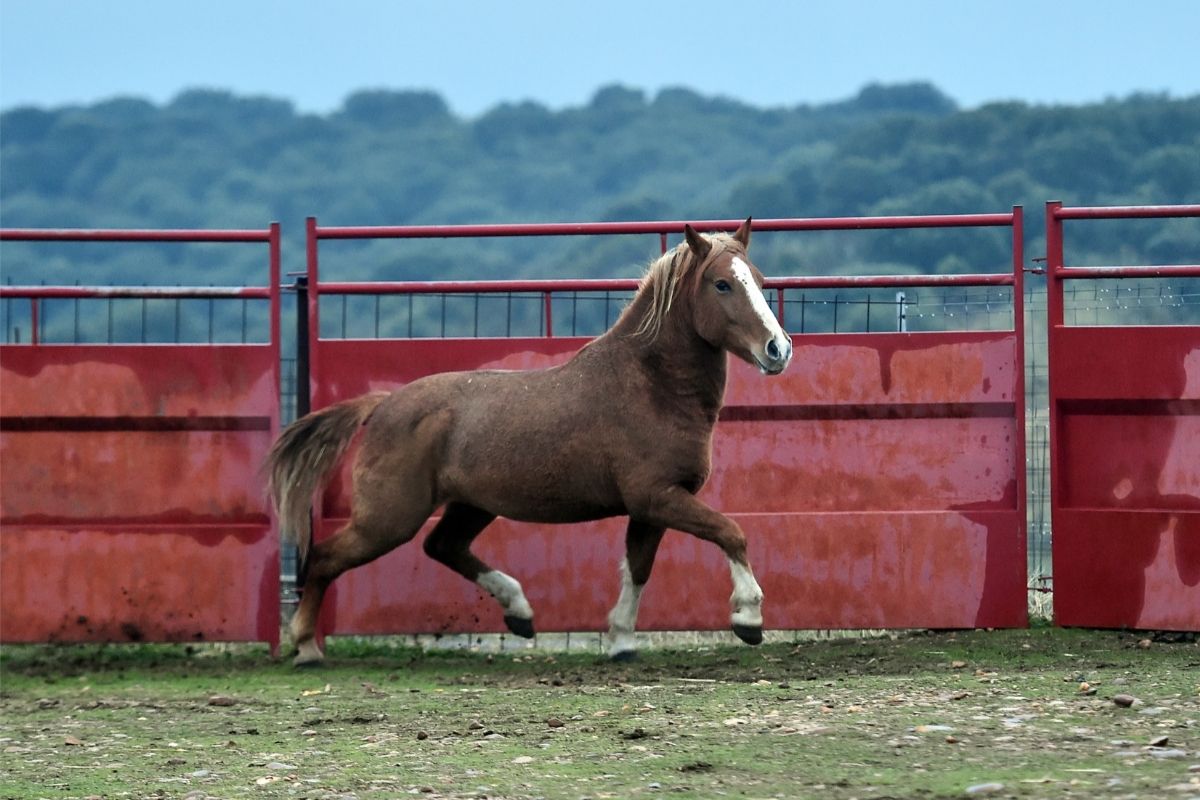
Suffolk Punch
Quick Facts
Country of Origin: Suffolk, England
Height: 16 to 18 hands (1.6 to 1.8 meters)
Weight: 1,900 to 2,200 pounds (855 to 990 kilograms)
Life Expectancy: 25 to 30 years
Feeding: Hay, grain, fruits, and vegetables
Time of Development: 1600
As the name suggests, the Suffolk Punch horse originated from Suffolk, England. Horse lovers have referred to Suffolk as the home of big horses since the 1600s. Suffolk Punch is Great Britain’s oldest domestic horse, specifically bred for farm work.
Suffolk is a hard working horse breed historically bred for agricultural labor like forestry and other draught work. Today, these horses are commonly used in films, horse sports, and pulling heavy drays for breweries.
All Suffolk Punch horses are chestnut in color. Some have white markings on the face and legs but are very rare. They have short, muscular legs with dense bones. This horse breed is referred to as the “Suffolk Punch” because of its general rounded appearance.
Intelligence, strength, and the willingness to work are some of the key attributes of Suffolk Punch. The Suffolk is also commonly used for crossbreeding. It makes a great choice for heavy horse riders.
This horse breed consumes less food than other large horse breeds, making it the easiest to domesticate. They will be happy to have a regular hay, vegetables, and fruits diet.
The number of Suffolk horses quite went down in the late 1940s and almost became depleted in the 1950s. This downward curve has progressed over the years, leaving very few of these horses today. Because of this reduction, the American Livestock Breeds Conservatory considered these breeds’ status to be critical.
Shire
Quick Facts
Country of Origin: Lincolnshire, England
Height: 17 to 18 hands (1.7 to 1.8 meters)
Weight: 1,800 to 2,400 pounds (810 to 1080 kilograms)
Life Expectancy: 2 to 30 years
Feeding: Hay, grain, fruits, and vegetables
Time of Development: 1850
The Shire is the biggest horse in the world. Shire horses were developed in Britain during the 18th century and are named after the English they originated.
This horse breed is famous for its tall, muscular build and long feathered legs. This breed is typically black, gray, bay, brown, or chestnut. They also have a friendly, easy-going temperament.
The shire horses are hardworking and have no known behavioral issues. Despite being huge horses, they are naturally calm, dependable, and patient. This horse breed is commonly crossed with the Clydesdale to form the Clydesdale shire horse. Read our article and find out Shire Horse vs. Clydesdale – The DIFFERENCE.
Shire horses consume hay, vegetables, and fruits. They require a large amount of horse food to maintain their energy levels and stay healthy. Their need for too much food makes them an expensive breed to domesticate.
With a talent for weight-pulling, these horses were historically bred as workhorses. Today, farmers with small farms still use Shire horses on their farms. They make a great eco-friendly alternative to tractors. They are also commonly used for horse riding and TV shows.
However, due to technological developments in the transport sector, people have turned to the new means of carriage. These changes have resulted in a significant decrease in the number of shire horses. The American Shire Horse Association continues to put in an effort to ensure that this breed does not become extinct.
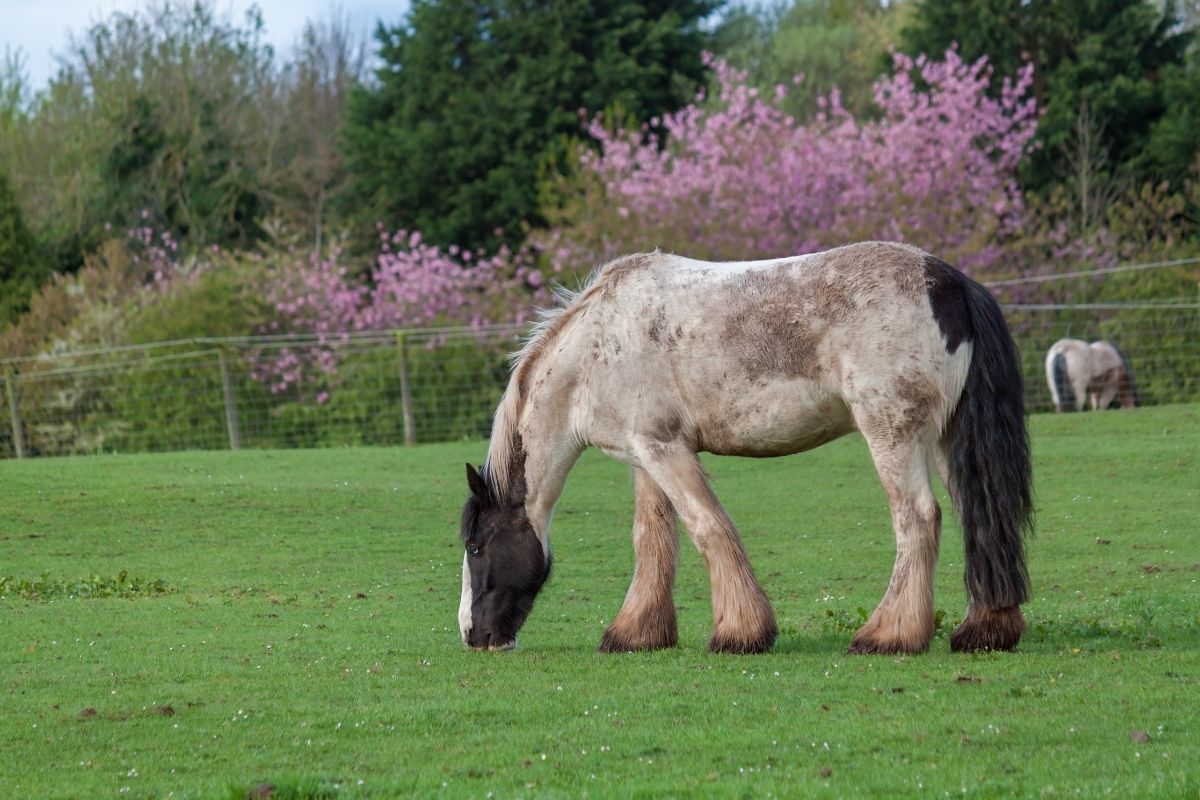
Conclusion
When it comes to horses, size does matter! The largest breed of horses in the world is daft horses. These horses were mainly domesticated for their size and strength. Humans mainly used these horses for pulling heavy wagons, plowing, and logging.
Large horse breeds are beautiful and can help with a wide range of work. Some, like the Suffolk Punch, were even domesticated for meat! Today, these gentle giants are useful in horse sporting activities, shows, and films.
